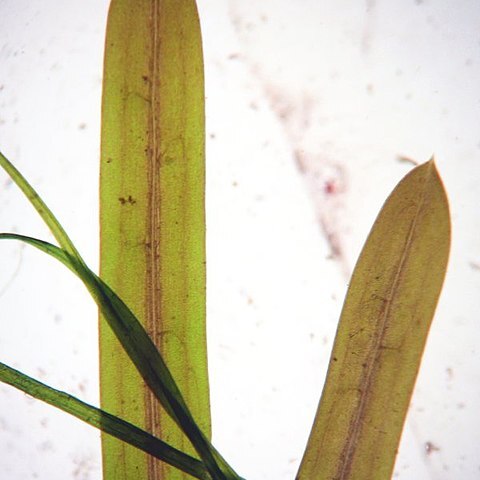Stem to 1 m or more, sparingly branched below, often more freely so above, slightly compressed, to 1 mm wide, commonly with paired glands at the nodes; rhizome scarcely developed; lvs all submersed, linear, 3–7 cm × 1.5–3 mm, minutely cuspidate at the obtuse or rounded tip, (3)5–7(9)-veined, the lateral veins very delicate, the midvein flanked by a row of lacunar cells on each side extending two-thirds its length, or these wanting; stipular sheaths axillary, free, white,0.5–2 cm, closed at base when young, becoming fibrous in age; winter-buds commonly produced, 1.5–5 cm, the inner lvs reduced and arranged into a fan-shaped structure, set at right angles to the outer lvs;peduncles 1.5–5 cm, flattened and clavate; spike slender, 8–18 mm, with 2–5 remote whorls of fls; frsovoid to obovoid, 2–3 mm, with rounded sides, not or scarcely keeled; 2n=26. Chiefly in calcareouswaters; Que. and Nf. to Mack. and Alas., s. to N.J., Pa., and Ind., n. Io., Nebr., and Utah.
Plants annual, submerged in fresh water. Rhizome absent or present. Stems filiform, compressed, sparsely to densely branched; nodal glands present; turions terminal or axillary, composed of 2 or 3 outer leaves and a fan-shaped structure from stipules oriented at 90° to leaves. Stipules 7-25 mm, fused at base, but at upper portion split into 2 remnants, fibrous, creamy white when dry; leaves sessile, linear, 2.3-6.5 cm × 1.2-3.2 mm, (3-)5(-7)-veined, lacunae lacking or 1 narrow row per side of midvein, apex mucronate. Spike with 4-8 flowers, 7-16 mm in fruit. Carpels 4. Fruit obovoid, 1.8-2.5(-3) mm, lacking keel; beak erect, 0.3-0.7 mm. Fl. and fr. Jun-Aug. 2n = 26.


